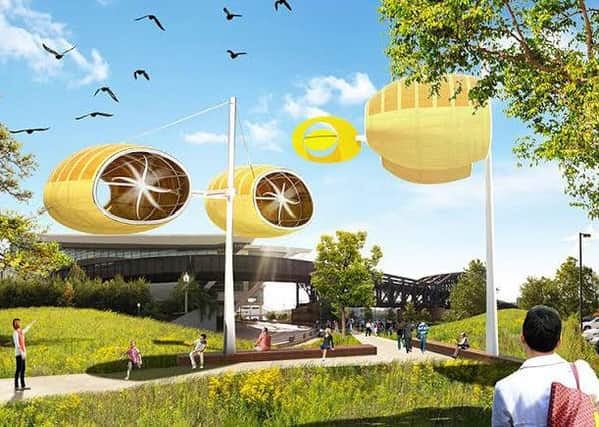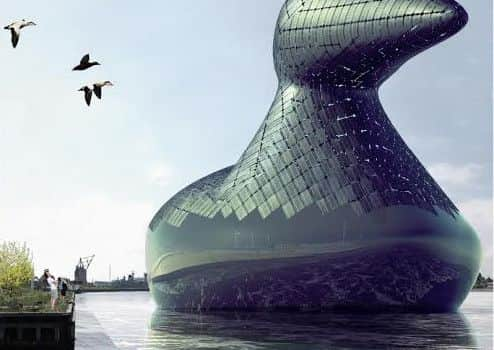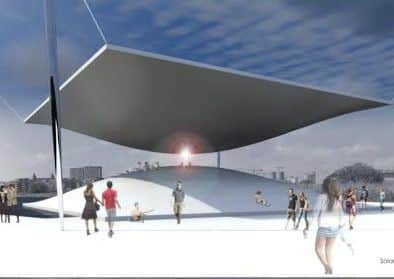Green energy scheme aims to bring beauty to renewables


A challenge to make “beautiful renewables” that combine high quality public art with the next generation of green energy schemes is now underway in Scotland. Architects from New York, Los Angeles and Berlin are advising three Scottish teams of creatives and scientists who are competing to design a renewables scheme at Dundas Hill , Glasgow, that is capable of powering at least 50 new homes.
The open competition is part of the Land Art Generator Initiative (LAGI), set up by American couple Elizabeth Monoian and Robert Ferry.
Advertisement
Hide AdAdvertisement
Hide AdThey ran their first contest in Abu Dhabi in 2010 after being inspired by the new cities being developed in the Emirate.


Their aim is to create green electricity developments which become attractions in their own right – with bold, forward thinking design at the heart of the clean power plants.
Now the Land Art Generator Initiative has come to Glasgow at a time when more renewable developments are being created in city environments with a drive away from the ubiquitous and often opinion-splitting wind turbine.
Chris Fremantle, founder of ecoartscotland, anart and ecology research practice, said Scotland was prime territory to embrace the Land Art Generator ethos given the urgent need to meet green energy targets in the country - and the need to get the public on board with renewable projects.
Mr Fremantle said: “One of the really exciting things about Land Art Generator is that it pushes to the edge what we think is possible.


“Glasgow would like to be a centre for excellence for renewable energy. It is a city of excellence for engineering and now it could be a powerhouse for renewable energy.
“Watt came up with the idea for a steam engine while walking about Glasgow Green, now it is all about renewables and taking the city from steam to green.”
He said good design could move renewable power away from the “monotony” of wind turbines, which some people found offensive.
Advertisement
Hide AdAdvertisement
Hide Ad“In the past, utility scale energy used to be positioned quite close to cities but as we managed to maximise voltages the developments moved away from the urban environment.
“Because of the really serious renewable energy targets we have, there will be a lot more energy being produced in cities than we are used to.
“There is also this challenge of around landscape and how energy production fits into that.”
LAGI has built up a portfolio of 600 pioneering renewable developments since it began in 2010.
Among them is WindNest, the winner of its first open competition.
Due to be built in Pittsburgh, Pennsylvania, WindNest is a series of elevated wind turbines housed in ‘cloud pods’ made from a solar fabric.
It is designed so that people can move between the structure, with the clouds moving above overhead as they shift in line with wind direction.
At night, the artwork glows to illuminate the benches below where passers-by can sit and charge their phones, making it a useful – and practical – public space.
Advertisement
Hide AdAdvertisement
Hide AdAnother recent submission to LAGI includes the Energy Duck, a 12ft high sculpture designed to float on a pond in Copenhagen.
It marks the decline of habitats for the common eider duck due to climate change while acting as a huge store for renewable energy.
The sculpture is designed to be covered in standard solar panels, collecting sunlight and storing it in the duck’s belly. Some is stored using water pressure and at night when the sun dips, some of the pressure is released to insure the duck is producing renewable energy at all times.
The Solar Hour Glass, designed by a team in Buenos Aries, won the LAGI competition in 2014. Once built, it could power 860 homes through hundreds of small flat mirrors which draw sunlight before concentrating the energy into a receiver. This then heats up fluid to around 600 degree Celsius before powering a generator with steam.
Mr Fremantle said that in Glasgow, the hope was to produce something beautiful that could produce a significant amount of renewable energy, all with the community’s support.
He said: “In Glasgow, what we want to do is really explore what is possible at the moment.”
The competition is being supported by Glasgow City Council, Scottish Canals and Igloo Regeneration.
It is hoped the three teams will come up with their first designs next Spring with a public exhibition of ideas to be held next year. The Land Art Generator demonstrates the role that artists, designers and architects can play firstly developing new functional and aesthetic forms,